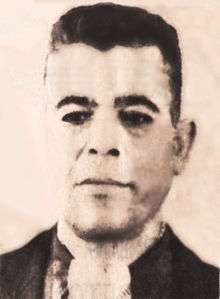Hadj Bouchiba
| El Hadj Bouchiba | |
|---|---|
 | |
| Background information | |
| Birth name | Abdelghani Bouchiba |
| Born |
1903 Algiers, Algeria |
| Died |
January 5, 1957 Algiers, Algeria |
| Genres | Chaabi |
| Occupation(s) | Singer, musician |
Hadj Bouchiba (1903 – January 5, 1957)[1] was an Algerian songwriter, lyricist, composer, poet and painter.
Biography
Abdelghani Bouchiba was born in Constantine in 1903 but moved very young to Algiers with his father, Salah, who had two Arabic style shoe stores in the Casbah of Algiers (rue Médée and rue Randon). In 1923 he lived with his parents in Rampe Valée. He was called to do his military service in the Navy and after his demobilization has worked in tobacco at Ets Azoulay then at Job, first as a mechanic and later Machine driver. After finishing the service Bouchiba devoted himself with much more determination to music, that is to say from 1924 to 1925. His fledging in the art were those received by the master Mustapha Nador with whom he worked for a time relatively short on tenor banjo. But it is especially in the neighborhood "El Koudia" in the Casbah that Bouchiba had time to learn from another musician Lounès Kamissa who held at the same time a tavern frequented by youngsters of the Casbah. Two other places have also preciously served Bouchiba to ensure beneficial repetitions, one provided by Ayad Kehioudji (Mohand Erroumi), Hadj M'rizek's half-brother a trusted name and a man versed in this art in Bab-El-Djedid, and the other at Hadj Sellili's, both in the upper Casbah. During the same period in 1932–33, Bouchiba managed two coffees: one in Belachère street at the "Souikia" of Hadj Slimane and the other "El Koudia" in association with Kehioudi and other well-known figure of Algiers Hadj Brahim who himself had some time managed the café de la Pêcherie, a much preferred place by secure customers.
Back in 1926 Bouchiba's orchestra featured Si Mohrabia (tenor banjo), Hadj Abderrahmane Guechoud (cenitra) and sometimes Dahmane a.k.a. Ghouidi sometimes H'mida as drummers and even earlier, like on the first live evening performance provided by Bouchiba at Abdelkader Kourour's wedding on Benali Sidi street at the Casbah, featured a band formed with Bismark (cenitra) and Baba Dahmane (violin).
After a debut in the "medh chaabi" genre, where Mustapha Nador was an absolute master at the time, gradually Bouchiba opted for "El Arrobi" which was to lead him to a higher stage and admired by people from the "Fahs" (Sahel) where Bouchiba occupied a prominent place.
Bouchiba learns at the Brahim Fatah school in Arabic and French under the direction of master Fatah himself in El Koudia where Abdelghani at an early had manifested age with exceptional intelligence both inside and outside of school. Around 1935–36, Bouchida becomes Hadj after his pilgrimage to the Holy Places of Islam (Mecca). He had made the trip as an employee on a boat convoy. In these same years, Hadj Bouchida had climbed the echelons in his profession, he became very sought and found thanks to his serious and regular work. Bouchida had a chosen clientele did not work for the first applicant but only for those who appreciated his art. It is in this sense that he was able to make his job envied, sacrificing the monetary side. Hadj Bouchida has evolved over time and his orchestra instrumentalists were also a valuable contribution to his development. Men like Si Moh Rabia, Kaddour Cherchalli together with Mohamed Tailleur and Hadj Boukema were real banjo specialists while Sid Ali Kalb Ellouz, Moh Saghir Laama had sufficiently proved their worth in the mandole and oud and Baba Dahmane violin, Bismark cénitra.
On January 5, 1957 at 19 o'clock Bouchiba fall under the bullets of La Main Rouge a colonial secret organization, leaving a large gap in the Algerian music scene. He rests at the El Kettar Cemetery.
Songs
- Mahl El Djoudi
- Ya akhina[2]
- Ya Doukar Edjnani
- Sbouhi
Bibliography
Bendamèche, Abdelkader (2006). Un artiste de légende (in French). Algiers: Éditions de la bibliothèque nationale d'Algérie. p. 55.
References
- ↑ "Culture : AYANT EU DE NOMBREUX ADEPTES Le chaâbi entre histoire et théorie". Le Soir d'Algérie. March 9, 2006. Retrieved April 2, 2014.
- ↑ performed by Kamel Bourdib